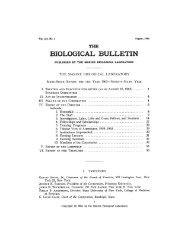General embryological information service - HPS Repository
General embryological information service - HPS Repository
General embryological information service - HPS Repository
Create successful ePaper yourself
Turn your PDF publications into a flip-book with our unique Google optimized e-Paper software.
"DIE VORGEBURTLICHEN ENTWICKLUNGSSTADIEN<br />
DES MENSCHEN"<br />
1961<br />
by E. Blechschmidt S. Karger, Basel<br />
688 pp., 579 figs., 6 tbs. Price: s.Fr. 96.—<br />
This large volume is essentially an atlas. It is predominantly concerned with<br />
the first two months of development, i.e. the stages leading up to the establishment<br />
of the basic anatomical pattern. Although the treatment is continuous,<br />
three main sections may be distinguished, viz. "ova", "embryos" and "body<br />
regions with their organs".<br />
Throughout the book German and English are used side by side in parallel<br />
fashion. The basic plan of the book is such that the righthand page always<br />
shows the plates, while on the facing page appear the legends to the figures,<br />
and a verbal account of the processes illustrated.<br />
No attempt has been made to designate the stages depicted by numbers or<br />
letters. The length of the embryos is used as the stage criterion troughout,<br />
while days, weeks and months are used to subdivide the development into<br />
general periods, which are indicated at the tops of the plates in the first two<br />
sections. In the third section their place is taken by indications of the organs<br />
shown.<br />
The illustrations, partly drawings, partly photographs, are of superb quality,<br />
which is in part the result of outstanding techniques of reproduction and<br />
printing.<br />
The theoretical background for the interpretation of the plates is formed by the author's<br />
original ideas concerning the "biodynamic" factors underlying developmental processes. These<br />
factors are envisaged mainly as geometrical and mechanical interrelations, growth movements,<br />
etc. It will be understood that this feature gives the book a rather pronounced personal quality.<br />
The book also contains a glossary, a restricted list of references, a very brief tabular<br />
outline of the history of embryology, age tables of human embryos, a tabular survey of<br />
ossification, and finally a very extensive subject index. Lay-out and printing of the book<br />
are excellent.<br />
"LEITFADEN DER ENTWICKLUNGSGESCHICHTE<br />
DES MENSCHEN"<br />
6th edition, 1961<br />
by H. Boenig f VEB Georg Thieme<br />
(revised by R. Bertolini) Leipzig<br />
320 pp., 263 figs. Price: DM 20.40<br />
This is a revised edition of a book which appeared first in 1937, and underwent<br />
no essential changes until the fifth edition (1953). In the present edition<br />
the advances of the last two decades have now been incorporated. The illustrative<br />
material has also been thoroughly revised and extended.<br />
The book was written especially for the use of medical students, and<br />
therefore exclusively concerns the human embryo until term. Literature references<br />
are not given. The treatment is limited mainly to morphogenesis,<br />
histogenesis being treated occasionally. Developmental anomalies are also<br />
treated only occasionally.<br />
The book is in three sections, one dealing with gametes, menstruation and<br />
fertilization, one with early development, placentation and gravidity, and one<br />
with organ development. The illustrations are numerous and on the whole of<br />
good quality.<br />
The book is concluded by a subject index.<br />
272
















